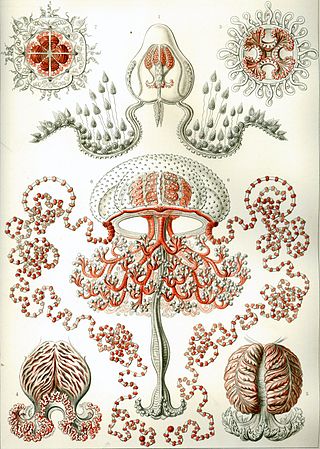
The Scyphozoa are an exclusively marine class of the phylum Cnidaria, referred to as the true jellyfish.

Hydrozoa is a taxonomic class of individually very small, predatory animals, some solitary and some colonial, most of which inhabit saline water. The colonies of the colonial species can be large, and in some cases the specialized individual animals cannot survive outside the colony. A few genera within this class live in freshwater habitats. Hydrozoans are related to jellyfish and corals and belong to the phylum Cnidaria.

Obelia is a genus of hydrozoans, a class of mainly marine and some freshwater animal species that have both polyp and medusa stages in their life cycle. Hydrozoa belongs to the phylum Cnidaria, which are aquatic organisms that are relatively simple in structure with a diameter around 1mm. There are currently 120 known species, with more to be discovered. These species are grouped into three broad categories: O. bidentata, O. dichotoma, and O. geniculata. O. longissima was later accepted as a legitimate species, but taxonomy regarding the entire genus is debated over.

Aequorea victoria, also sometimes called the crystal jelly, is a bioluminescent hydrozoan jellyfish, or hydromedusa, that is found off the west coast of North America.

Gonionemus is a genus of hydrozoans that uses adhesive discs near the middle of each tentacle to attach to eelgrass, sea lettuce, or various types of algae instead of swimming. They are small and hard to see when hanging onto swaying seaweed. Nevertheless, they are capable of swimming when necessary. The bell is transparent, revealing the four orange to yellowish-tan gonads that lie along most of the length of the four radial canals. The pale yellow manubrium has four short, frilly lips. Up to 80 tentacles line the bell margin, with about an equal number of statocysts. Copepods are a favored prey.

Pelagia noctiluca is a jellyfish in the family Pelagiidae and the only currently recognized species in the genus Pelagia. It is typically known in English as the mauve stinger, but other common names are purple-striped jelly, purple stinger, purple people eater, purple jellyfish, luminous jellyfish and night-light jellyfish. In Greek, pelagia means "(she) of the sea", from pelagos "sea, open sea"; in Latin noctiluca is the combining form of nox, "night"", and lux, "light"; thus, Pelagia noctiluca can be described as a marine organism with the ability to glow in the dark (bioluminescence). It is found worldwide in tropical and warm temperate seas, although it is suspected that records outside the North Atlantic region, which includes the Mediterranean and Gulf of Mexico, represent closely related but currently unrecognized species.

Alatina alata(Reynaud, 1830), often called a sea wasp, is a species of box jellyfish found in the Pacific, Indian and Atlantic Oceans and in the Caribbean and Arabian Sea.

Trachymedusae belong to the phylum Cnidaria and the class Hydrozoa, among the 30 genera are 5 families containing around 50 species in all, the family Rhopalonematidae has the greatest diversity.

Anthoathecata, or the athecate hydroids, are an order of hydrozoans belonging to the phylum Cnidaria. A profusion of alternate scientific names exists for this long-known, heavily discussed, and spectacular group. It has also been called Gymnoblastea and, Anthomedusa,Athecata, Hydromedusa, and Stylasterina. There are about 1,200 species worldwide.

Aequorea forskalea is a species of hydrozoan in the family Aequoreidae. Discovered in 1810 by Péron and Lesueur, A. forskalea was initially found in coastal to offshore waters of the Mediterranean Sea. This species is commonly referred to as the many-ribbed jellyfish. The species is often mixed up with some other members of the genus due to some similarities including the capability of bioluminescence.

Cladonematidae is a small family of anthomedusan hydrozoans. They have stolonal hydroid colonies, and their medusae are benthic and can crawl across the sediment; in many species they have lost the ability to swim however.
Lovenellidae is a family of hydrozoans. Their hydroids live together in upright stolonal or sympodial colonies, and their gonophores are pedunculate free-roaming medusae. The relationships of this fairly small but distinctive radiation to other members of the order Leptothecata are not well understood at present.
Vallentinia gabriellae, the hitch-hiking jellyfish, is a species of small, inconspicuous hydrozoan in the family Olindiidae. It is endemic to a few isolated parts of the western Atlantic Ocean. It is elusive in the wild but sometimes makes its appearance unexpectedly in seawater cultures of other organisms in the laboratory.

Olindias is a genus of hydrozoans in the family Olindiidae.

Chiropsalmus quadrumanus, commonly known as the four-handed box jellyfish, is a species of box jellyfish found in the western Atlantic Ocean, the Gulf of Mexico and the Pacific Ocean. The sting is venomous and dangerous to humans, especially children.
Bougainvillia aberrans is a marine invertebrate, a species of hydroid in the suborder Anthomedusae. It was first described by Dale Calder in 1993. They have four radical clusters of marginal tentacles. Bougainvillia aberrans is found in Bermuda in the western North Atlantic Ocean.
Maeotias is a genus of hydrozoans in the family Olindiidae. It is a monotypic genus with only a single species, Maeotias marginata, commonly known as the Black Sea jellyfish or brackish water hydromedusa and often referred to as Maeotias inexpectata in the literature. It was first described from the Don and Kuban estuaries of the Sea of Azov, and also occurs in the Black Sea, all of which are areas of low salinity. It has been recorded in several other estuarine locations around the world and is regarded as an invasive species.
Haliscera bigelowi is a species of deep sea hydrozoan of the family Halicreatidae.
Haliscera conica is a species of hydrozoan belonging to the family Halicreatidae.

Aglantha digitale is a species of hydrozoan in the family Rhopalonematidae. It is found in the Arctic and sub-Arctic where it is one of the most common jellyfish. It is unusual in having both a slow swimming action, through pulsating its bell, and a rapid escape response.














